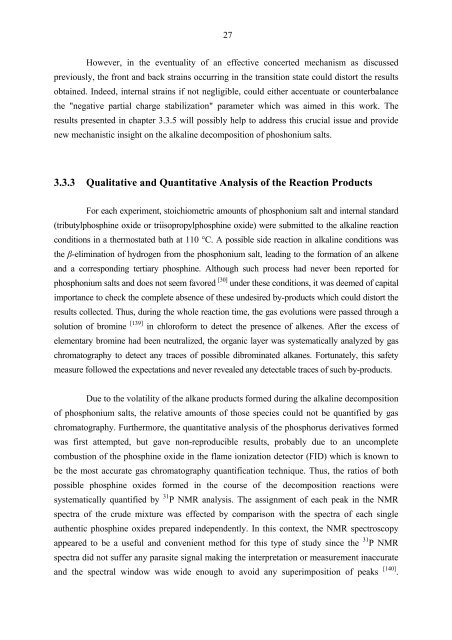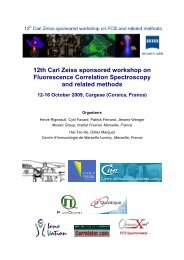My PhD dissertation - Institut Fresnel
My PhD dissertation - Institut Fresnel
My PhD dissertation - Institut Fresnel
You also want an ePaper? Increase the reach of your titles
YUMPU automatically turns print PDFs into web optimized ePapers that Google loves.
27<br />
However, in the eventuality of an effective concerted mechanism as discussed<br />
previously, the front and back strains occurring in the transition state could distort the results<br />
obtained. Indeed, internal strains if not negligible, could either accentuate or counterbalance<br />
the "negative partial charge stabilization" parameter which was aimed in this work. The<br />
results presented in chapter 3.3.5 will possibly help to address this crucial issue and provide<br />
new mechanistic insight on the alkaline decomposition of phoshonium salts.<br />
3.3.3 Qualitative and Quantitative Analysis of the Reaction Products<br />
For each experiment, stoichiometric amounts of phosphonium salt and internal standard<br />
(tributylphosphine oxide or triisopropylphosphine oxide) were submitted to the alkaline reaction<br />
conditions in a thermostated bath at 110 °C. A possible side reaction in alkaline conditions was<br />
the β-elimination of hydrogen from the phosphonium salt, leading to the formation of an alkene<br />
and a corresponding tertiary phosphine. Although such process had never been reported for<br />
phosphonium salts and does not seem favored [30] under these conditions, it was deemed of capital<br />
importance to check the complete absence of these undesired by-products which could distort the<br />
results collected. Thus, during the whole reaction time, the gas evolutions were passed through a<br />
[ ]<br />
solution of bromine 139 in chloroform to detect the presence of alkenes. After the excess of<br />
elementary bromine had been neutralized, the organic layer was systematically analyzed by gas<br />
chromatography to detect any traces of possible dibrominated alkanes. Fortunately, this safety<br />
measure followed the expectations and never revealed any detectable traces of such by-products.<br />
Due to the volatility of the alkane products formed during the alkaline decomposition<br />
of phosphonium salts, the relative amounts of those species could not be quantified by gas<br />
chromatography. Furthermore, the quantitative analysis of the phosphorus derivatives formed<br />
was first attempted, but gave non-reproducible results, probably due to an uncomplete<br />
combustion of the phosphine oxide in the flame ionization detector (FID) which is known to<br />
be the most accurate gas chromatography quantification technique. Thus, the ratios of both<br />
possible phosphine oxides formed in the course of the decomposition reactions were<br />
systematically quantified by 31 P NMR analysis. The assignment of each peak in the NMR<br />
spectra of the crude mixture was effected by comparison with the spectra of each single<br />
authentic phosphine oxides prepared independently. In this context, the NMR spectroscopy<br />
appeared to be a useful and convenient method for this type of study since the 31 P NMR<br />
spectra did not suffer any parasite signal making the interpretation or measurement inaccurate<br />
[ ]<br />
and the spectral window was wide enough to avoid any superimposition of peaks 140 .













